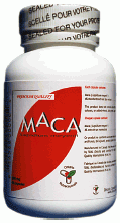|
Maca was cultivated
by the Pumpush, who settled on the high plains of Bombon
(3,700 to 4,500 m.a.s.l ) in the years 1,200 to 100 B.C.
In Pre-Columbian times it was used as a food and in magic-religious
rites, since then it has been recognized for its fertility
enhancing properties. According to the chronicles from the
16th and 17th centuries, it was used as a food for Inca
soldiers because of its capacity to promote physical strength.
In Colonial times, Maca was used for payment
of taxes. In addition to use by native populations, it is
believed to have been consumed by the Spaniards, especially
in journeys at high altitudes, who valued not only its nutritional
effect but also its fertility enhancing properties. As a
result from the papal bull from Pope Gregory XV on March
10 / 1,623 "against malicious spells, curses, sorcery,
divorce, impotency, women's fertility and men's virility",
co-habitation, foods, rabbits, guinea pigs and plants -
including Maca - were destroyed, because
they were incitements to fraud idolatry. Thus, cultivation
and consumption of Maca were greatly reduced.
Directions:
Take 3 - 6 capsules per day before meal(s).
Bottles: 60 and 120 capsules
Each capsule: 500 mg
|

|

